February 24, 2012 – The United States' venerable upper stage rocket — the Centaur — that created the pathway to the moon and to every planet across the solar system made its 200th flight on Friday (Feb. 24) in a milestone mission to boost the Navy's new mobile communications satellite to orbit.
Soaring atop a United Launch Alliance (ULA) Atlas V 551 rocket, the 200th Centaur lifted off supporting the Navy's first Mobile User Objective System (MUOS) satellite. The 5:15 p.m. CST (2215 GMT) launch began from Complex 41 at the Cape Canaveral Air Force Station in Florida.
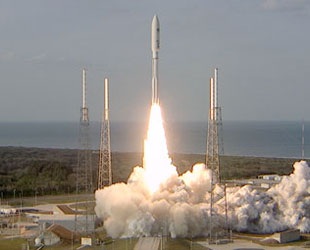
The 200th Centaur upper stage lifts off atop an Atlas V rocket on Feb. 16, 2012 with the Navy's MUOS-1 satellite. (ULA) |
Originally developed by General Dynamics (GD) under the direction of NASA at the dawn of the space age, Centaur was first conceived to power payloads with a high-energy cryogenic engine fed with liquid hydrogen and oxygen.
"Centaur makes it possible for the United States to launch spacecraft of much greater size and weight then ever before," NASA said on the eve of the rocket's first launch in May 1962. "Hydrogen offers more pounds of thrust per pound of propellant consumed per second than any other fuel possible in chemical rockets."
The Centaur upper stage was at the forefront of advancing rocket technology by conquering cryogenic fuels, a key accomplishment that benefited a host of different space boosters to follow.
"Centaur has been pioneering space launch for the last 50 years. The first launches in the early 1960s demonstrated the extremely high performance that can be achieved with a liquid hydrogen/liquid oxygen rocket stage. LH2/LO2 stages were subsequently used for the Saturn I, Saturn V, space shuttle, Titan and Delta programs," Jim Sponnick, United Launch Alliance's (ULA) vice president for mission operations, said.
"Centaur developed and demonstrated in-flight restarts for LH2/LO2 engines — a technology that was critical for the Apollo programs and also for enabling a wide variety of flexible mission designs," said Sponnick.
The first flight-test came in May 1962, but the motor never got a chance to fire because the Centaur insulation panels came off prematurely and the vehicle exploded a minute after liftoff.
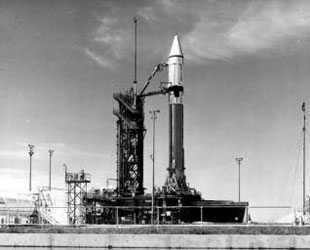
An early Centaur upper stage sits atop an Atlas rocket on Jan. 3, 1962. The first Atlas-Centuar lifted off on May 8, 1962. (AFSMM) |
Success came on the second launch in November 1963, injecting the Centaur into Earth orbit where it continues to loop today in an elliptical perch ranging from 290 to 840 miles.
The project had a difficult development. Insulating the Centaur stage to preserve the supercold liquid hydrogen propellant at -423 degrees Fahrenheit (-253 Celsius) was a major challenge and keeping the fuel "bottomed" in the tank to relight the engine in space proved temperamental.
Several of the early launches failed due to a variety of issues including a steering problem on flight three and the inability to get the engines restarted on flights four and seven as the ullage thruster design was worked out.
Successful single-burn missions were repeated over and over, then a good restart of the engine in orbit occurred on flight ten as the Centaur moved closer toward perfection.
To the moon, Mars and beyond
"Centaur has delivered scientific missions to explore the sun, our moon and every planet in our solar system," said Sponnick.
The first operational payloads were the Surveyor probes between 1966 and 1968 that saw a series of landers touch down on the surface of the Moon.
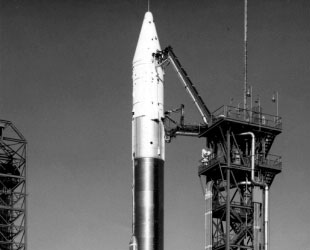
An Atlas-Centaur launches on May 30, 1966 with Surveyor I, the first U.S. spacecraft to make a soft-landing on the moon. (NASA) |
Other notable early spacecraft that successfully reached orbit on Centaur stages were the Orbiting Astronomical Observatory ultraviolet telescope, Mariners 6 and 7 that performed photo reconnaissance flybys of Mars in 1969 and Mariner 9 that became the first spacecraft to enter orbit around another planet — Mars — in 1971.
Then came Pioneers 10 and 11 on mankind's first journey to explore the outer solar system, lifting off from Complex 36 in Cape Canaveral, Fla., in March 1972 and April 1973, respectively.
Pioneer 10 made the first close encounter with Jupiter in December 1973 before being flung out on an escape trajectory from our planetary neighborhood. Pioneer 11 also visited Jupiter before continuing on to make the first flyby of Saturn and getting sent on its own escape path.
At the end of 1973, Mariner 10 took off to cruise by Venus and use that planet's gravity as a sling shot to venture further inward in the solar system to become the first craft to visit Mercury.
Besides NASA scientific probes, Centaurs were flying in the early days on communications spacecraft deployment flights for Intelsat, the International Telecommunications Satellite Organization.
Centaurs were also married with Titan boosters as a third stage, propelling the Viking 1 and 2 orbiter/lander combo missions in 1975 for their journeys to Mars. The four spacecraft operated in orbit and on the surface from 1976 through the early 1980s, transmitting to Earth more than 50,000 photos from the red planet.
Further exploits to the outer solar system — Voyagers 1 and 2 — also rode Centaurs atop their Titan rockets from the Cape in the summer of 1977. Both visited Jupiter and Saturn, then Voyager 2 continued on a grand tour to fly by Uranus and Neptune.
The planetary legacy of Atlas-Centaur included even more Pioneer missions — 12 and 13 — that went to orbit Venus in 1978.
The Navy's first Fleet Satellite Communications System spacecraft — FLTSATCOM 1 — was also lofted to orbit in 1978. That military comsat constellation was assembled by Atlas-Centaur vehicles through 1989, becoming the initial generation that eventually would be replaced by the UHF Follow-On program in the 1990s and now the MUOS mobile communications craft beginning with the launch on Thursday.
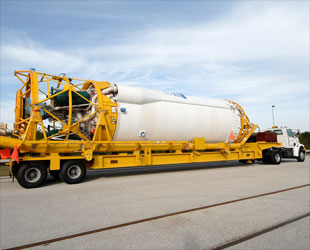
A Centaur upper stage is rolled to the launch pad for the Feb. 11, 2010 launch of NASA's Solar Dynamics Observatory. (NASA) |
In more recent years, high-profile missions like Cassini to Saturn, Mars Reconnaissance Orbiter and Mars Science Laboratory, New Horizons to Pluto and Juno to Jupiter have gotten successful starts on Centaur upper stages.
The rocket stage even reached the surface of the moon on a crashing experiment to hit a crater in the South Pole to search for evidence of water ice.
There's also been countless commercial communications satellites, geostationary weather observatories, military and classified spacecraft and the U.S. Air Force's X-37B orbital spaceplane that got to orbit thanks to the reliability of Centaur.
Then and now: The evolution of Centaur
Centaur upper stages have been configured in dual-engine and single-engine versions, serving multiple variants of Atlas and Titan, flying 176 times on Atlas and 23 times on Titan, and even was envisioned for use aboard the space shuttle starting in 1986 for planetary probes, but that plan was scrapped after Challenger.
The first RL10 engine was designed to generate about 15,000 pounds of thrust. Upgrades and advancements to the RL10A-4-2 that is now used on the Atlas V produces 22,300 pounds of thrust to push payloads to Earth orbit and beyond.
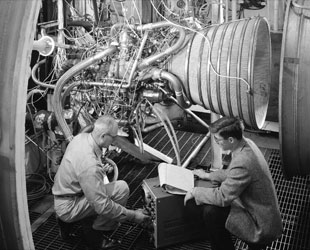
NASA engineers test a Centaur stage RL-10 engine in the Lewis Research Center's propulsion systems laboratory. (NASA) |
"The overall Centaur stage architecture [used today] is fundamentally the same as the versions flown in the early 60s — with a thin-walled, less than the thickness of a dime — stainless steel pressure-stabilized structure that provides the most weight-efficient stage possible, and also the Centaur is still powered by the very reliable and proven RL10 engine," Sponnick said.
"All the components, subsystems and overall capabilities have evolved dramatically over the last 50 years," said Sponnick. "The RL10 engine performance has improved substantially and the chamber pressure has doubled. The vacuum-tube based ignition system has been replaced with a solid-state, fault tolerant system. The hydraulic actuators for steering the RL10 engine have been replaced with fault-tolerant electromechanical actuators."
"The Centaur avionics have evolved through numerous generations," he said, "with the current system based on an extremely capable 8-processor, fault tolerant, ring laser gyro navigation system and flight computer."
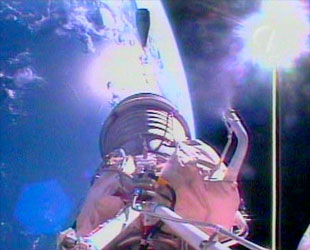
A modern RL10A-4-2 engine is revealed in Earth orbit after the first launch of an Atlas V rocket in August 2002. (Spaceflight Now) |
"The Centaur has grown in size, now carrying 50 percent more propellant than the early Centaur vehicles."
"These evolutionary changes over the five-decade history of the Centaur have made for an increasingly flexible and reliable upper stage that has tripled the performance capabilities of the first Centaurs developed and flown by rocket pioneers in the early 1960s," Sponnick said.
Remarkable success rate
After surviving a bumpy development in its early years, Centaur has proven to be a dependable booster for space. Over the course of its previous 199 launches over the past 50 years, only 11 Centaurs have failed, and over half of those malfunctions occurred in the 1960s and 70s.
The last outright failure happened aboard a Titan-Centaur in 1999 when a software error caused the stage to misfire, ending the mission of a USAF MILSTAR communications satellite.
Nearly half of all Centaur missions have flown in just the past two decades. The Atlas II and III programs wrote flawless records, amassing 69 launches from the 1990s through 2005, and now the Atlas V that has successfully launched 29 times in last 9 years.
"I and many of my coworkers clearly recall the 100th flight of the Centaur in April of 1995," said Sponnick. "It took 33 years for Centaur to accomplish those first 100 flights. The next 100 Centaur launches have been accomplished in 17 years."
A big payload for No. 200
Roaring off the launch pad at Cape Canaveral's Complex 41 on Friday, the latest Centaur was shrouded inside the bulbous nose cone of the Atlas V booster for its climb through Earth's atmosphere.
Its chance to perform began four-and-a-half minutes into the flight when the first stage dropped away and the RL10 engine fired to life for the first of three burns needed to heave the massive MUOS 1 spacecraft into the nominal orbit for the U.S. Navy.
At nearly 15,000 pounds (6,800 kilograms), the satellite is the heaviest payload ever launched by an Atlas rocket. Filled with state-of-the-art 3G cellular phone technology, MUOS 1 will provide an unprecedented level of capacity for mobile communications to U.S. and allied warfighters on the move.
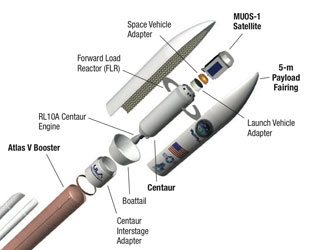
Diagram showing the configuration of the Centaur stage and the Navy's MUOS-1 communications satellite. (ULA) |
"The 200th flight of the Centaur is a very big milestone for the ULA team," said Sponnick before the launch.
Initially firing for almost 8 minutes, the Centaur reached a preliminary low-Earth orbit of 90 by 337 nautical miles (145 by 542 kilometers) in altitude, tilted 28 degrees to the equator, to begin the three step process of achieving the desired orbit.
Earlier Atlas V launches to geosynchronous transfer orbit have used just two engine burns, but MUOS will feature three firings.
"The three burn mission design for MUOS provides 1,000 pounds greater lift capability than a conventional two-burn geosynchronous transfer orbit," said Sponnick.
One final push nearly two hours and 57 minutes into flight about 15,000 nautical miles over the Indian Ocean will raise the orbit's low point and reduce the inclination closer to the equator. The burn, lasting less than a minute, will deploy the payload into a 1,870 by 19,323 nautical mile orbit at 19 degrees inclination.
"The MUOS 1 mission represents an excellent example of the performance and mission design capabilities of the Centaur," he said.
MUOS separates from the Centaur three hours and one minute after leaving Cape Canaveral, beginning its 15-year life for the Department of Defense. Controllers will spend about three months getting the craft maneuvered into a circular geosynchronous orbit positioned over the equator and checked out before putting it into service.
Copyright 2012 SpaceflightNow.com. All rights reserved.
